
(a)
Interpretation:
When the given compound is heated, ethene gas is evolved and a product with the formula
Concept introduction:
The Diels-Alder reaction is reversible at high temperature, and this process is called a retro Diels-Alder reaction. The mechanism for this reaction is as the reverse of a Diels-Alder mechanism i.e. the entire six-membered ring is break-down into the corresponding diene and the dienophile. The aromatic proton given signal range from
Answer to Problem 24.82P
The structure of
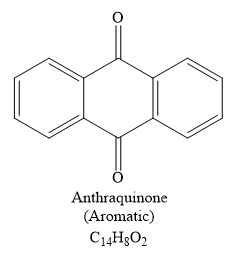
Explanation of Solution
The given compound is
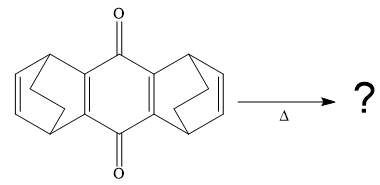
So when this compound is heated, ethene gas is evolved and a product with formula
The signal in
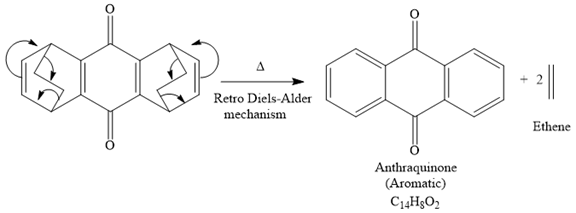
The product of the retro Diels-Alder reaction is also aromatic and matched with the given spectra and also ethene gas is evolved. so the above product is the correct one.
When the given compound is heated, ethene gas is evolved and a product with the formula
(b)
Interpretation:
When the given compound is heated, ethene gas is evolved and a product with the formula
Concept introduction:
The Diels-Alder reaction is reversible at high temperature and this process is called a retro Diels-Alder reaction. The mechanism for this reaction is as the reverse of a Diels-Alder mechanism i.e. the entire six-membered ring is broken down into the corresponding diene and the dienophile. The aromatic proton given signal range from
Answer to Problem 24.82P
The mechanism for the given reaction is
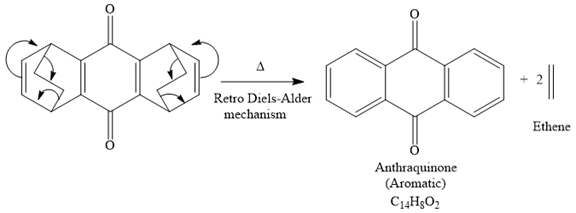
Explanation of Solution
The given compound is

So when this compound is heated, ethene gas is evolved and product with formula
The signal in
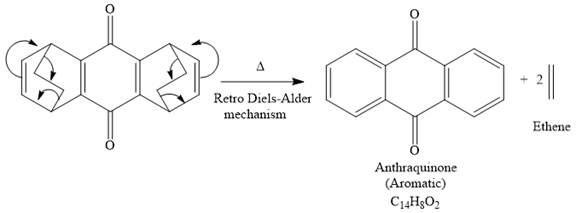
The product of the retro Diels-Alder reaction is also aromatic and matched with the given spectra and also ethene gas is evolved. So the above product and the mechanism (retro Diels-Alder mechanism) is the correct one.
When the given compound is heated, ethene gas is evolved and a product with the formula
(c)
Interpretation:
When the given compound is heated, ethene gas is evolved and a product with the formula
Concept introduction:
The Diels-Alder reaction is reversible at high temperature and this process is called a retro Diels-Alder reaction. The mechanism for this reaction is as the reverse of a Diels-Alder mechanism i.e. the entire six-membered ring is break-down into the corresponding diene and the dienophile. The aromatic proton given signal range from
Answer to Problem 24.82P
The main driving force that favours the product in the given reaction is the formation of a more stable aromatic compound.
Explanation of Solution
The given reaction is
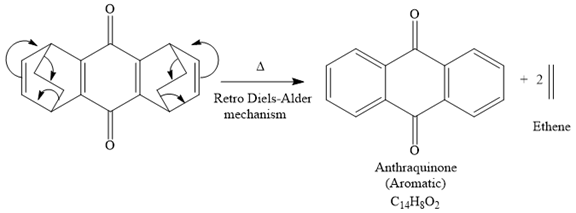
It is noticed that the starting material in the given reaction is overall non-aromatic and also possesses strain due to middle ethylene groups on both sides, but the product is aromatic and strain-free one. Since aromatic compounds are more stable than the non-aromatic compounds this is a key state and the main driving force for the given reaction.
When the given compound is heated, ethene gas is evolved and a product with the formula
Want to see more full solutions like this?
Chapter 24 Solutions
ORG CHEM W/ EBOOK & SW5 + STUDY GUIDE
- Nonearrow_forwardIn the phase diagram of steel (two components Fe and C), region A is the gamma austenite solid and region B contains the gamma solid and liquid. Indicate the degrees of freedom that the fields A and B have,arrow_forwardFor a condensed binary system in equilibrium at constant pressure, indicate the maximum number of phases that can exist.arrow_forward
- Part V. Label ad match the carbons in compounds Jane and Diane w/ the corresponding peak no. in the Spectra (Note: use the given peak no. To label the carbons, other peak no are intentionally omitted) 7 4 2 -0.13 -0.12 -0.11 -0.10 -0.08 8 CI Jane 1 -0.09 5 210 200 190 180 170 160 150 140 130 120 110 100 -8 90 f1 (ppm) 11 8 172.4 172.0 f1 (ppr HO CI NH Diane 7 3 11 80 80 -80 -R 70 60 60 2 5 -8 50 40 8. 170 160 150 140 130 120 110 100 90 -0 80 70 20 f1 (ppm) 15 30 -20 20 -60 60 -0.07 -0.06 -0.05 -0.04 -0.03 -0.02 -0.01 -0.00 -0.01 10 -0.17 16 15 56 16 -0.16 -0.15 -0.14 -0.13 -0.12 -0.11 -0.10 -0.09 -0.08 -0.07 -0.06 -0.05 -0.04 17.8 17.6 17.4 17.2 17.0 f1 (ppm) -0.03 -0.02 550 106 40 30 20 20 -0.01 -0.00 F-0.01 10 0arrow_forwardConsider the reaction of 2-methylpropane with a halogen. With which halogen will the product be almost exclusively 2-halo-2-methylpropane? 1. F2 2. Cl2 3. Br2 4. I2arrow_forwardNonearrow_forward
- Nonearrow_forwardn Feb 3 A T + 4. (2 pts) Draw the structure of the major component of the Limonene isolated. Explain how you confirmed the structure. 5. (2 pts) Draw the fragment corresponding to the base peak in the Mass spectrum of Limonene. 6. (1 pts) Predict the 1H NMR spectral data of R-Limonene. Proton NMR: 5.3 pon multiplet (H Ringarrow_forwardPart VI. Ca H 10 O is the molecular formula of compound Tom and gives the in the table below. Give a possible structure for compound Tom. 13C Signals summarized C1 C2 C3 C4 C5 C6 C7 13C shift (ppm) 23.5 27.0 33.0 35.8 127 162 205 DEPT-90 + DEPT-135 + +arrow_forward
- 2. Using the following data to calculate the value of AvapH o of water at 298K. AvapH o of water at 373K is 40.7 kJ/mol; molar heat capacity of liquid water at constant pressure is 75.2J mol-1 K-1 and molar heat capacity of water vapor at constant pressure is 33.6 J mol-1 K-1.arrow_forwardPart VII. Below are the 'HNMR 13 3 C-NMR, COSY 2D- NMR, and HSQC 20-NMR (Similar with HETCOR but axes are reversed) spectra of an organic compound with molecular formula C6H13 O. Assign chemical shift values to the H and c atoms of the compound. Find the structure. Show complete solutions. Predicted 1H NMR Spectrum ли 4.7 4.6 4.5 4.4 4.3 4.2 4.1 4.0 3.9 3.8 3.7 3.6 3.5 3.4 3.3 3.2 3.1 3.0 2.9 2.8 2.7 2.6 2.5 2.4 2.3 2.2 2.1 2.0 1.9 1.8 1.7 1.6 1.5 1.4 1.3 1.2 1.1 1.0 0.9 0.8 f1 (ppm)arrow_forward3. Draw the expanded structural formula, the condensed structural formula, and the skeletal structural formula for 2-pentene. expanded structure: Condensed structure: Skeletal formula: 4. Draw the expanded structural formula, the condensed structural formula, and the skeletal structural formula for 2-methyl-3-heptene. expanded structure: Condensed structure: Skeletal formula: following structurearrow_forward
 ChemistryChemistryISBN:9781305957404Author:Steven S. Zumdahl, Susan A. Zumdahl, Donald J. DeCostePublisher:Cengage Learning
ChemistryChemistryISBN:9781305957404Author:Steven S. Zumdahl, Susan A. Zumdahl, Donald J. DeCostePublisher:Cengage Learning ChemistryChemistryISBN:9781259911156Author:Raymond Chang Dr., Jason Overby ProfessorPublisher:McGraw-Hill Education
ChemistryChemistryISBN:9781259911156Author:Raymond Chang Dr., Jason Overby ProfessorPublisher:McGraw-Hill Education Principles of Instrumental AnalysisChemistryISBN:9781305577213Author:Douglas A. Skoog, F. James Holler, Stanley R. CrouchPublisher:Cengage Learning
Principles of Instrumental AnalysisChemistryISBN:9781305577213Author:Douglas A. Skoog, F. James Holler, Stanley R. CrouchPublisher:Cengage Learning Organic ChemistryChemistryISBN:9780078021558Author:Janice Gorzynski Smith Dr.Publisher:McGraw-Hill Education
Organic ChemistryChemistryISBN:9780078021558Author:Janice Gorzynski Smith Dr.Publisher:McGraw-Hill Education Chemistry: Principles and ReactionsChemistryISBN:9781305079373Author:William L. Masterton, Cecile N. HurleyPublisher:Cengage Learning
Chemistry: Principles and ReactionsChemistryISBN:9781305079373Author:William L. Masterton, Cecile N. HurleyPublisher:Cengage Learning Elementary Principles of Chemical Processes, Bind...ChemistryISBN:9781118431221Author:Richard M. Felder, Ronald W. Rousseau, Lisa G. BullardPublisher:WILEY
Elementary Principles of Chemical Processes, Bind...ChemistryISBN:9781118431221Author:Richard M. Felder, Ronald W. Rousseau, Lisa G. BullardPublisher:WILEY





